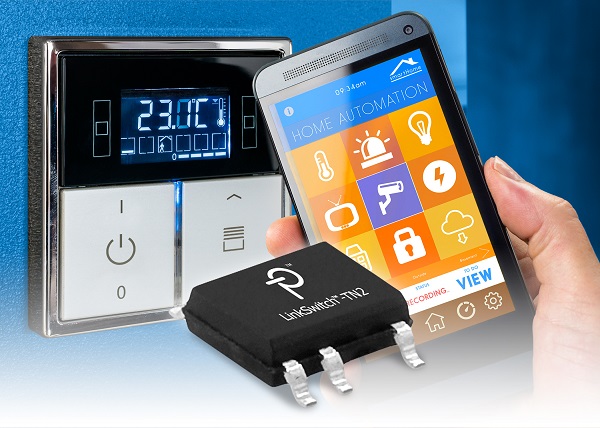Power Integrations, specializing in high-efficiency, high-reliability LED-driver ICs, announced a new reference design, DER-622, describing a smart wall switch compatible with wiring conditions most commonly found in residential retrofit installations.
Typically, smart wall switches with wireless connectivity, occupancy/vacancy sensing and/or voice control require a neutral return wire to power the unit, which is not always available in retrofit situations. No-neutral products are available for legacy incandescent bulbs because the small AC input current that is allowed to leak through the load when the smart-switch is in standby mode is insufficient to heat the filament. However, for LED and compact fluorescent designs, high standby-mode current from the smart-switch’s internal power supply can lead to unacceptable flicker often known as “ghosting,” caused by the leakage energy accumulating in the lamp and initiating intermittent start-up and brief light activation.
 |
|
Reference design for two-wire smart wall switch is compatible with retrofit wiring and LED lights (Image: Power Integrations) |
DER-622 illustrates a Bluetooth® Low Energy (LE) wall switch consuming less than 500 µA in standby mode. The design is based on Power Integrations’ LinkSwitch™-TN2 offline switcher ICs, which have quiescent consumption of less than 75 µA. The ICs’ ultra-low current consumption and high light-load efficiency ensure compatibility with energy-efficient LED bulbs rated down to 3 W and are ideal for no-neutral wall switch wiring.
LinkSwitch-TN2 devices may be configured to support flyback or buck topologies and deliver highly accurate output, providing voltage regulation of better than ±3%. The ICs enhance system reliability by incorporating numerous safety features including input and output over-voltage protection, over-temperature, and output short-circuit protection along with a rugged 725 V power MOSFET. In DER-622, the LinkSwitch-TN2 power supply IC is utilized in a non-isolated flyback topology and employs half-wave AC input rectification to reduce solution cost. The power supply provides two outputs – a 12 V rail to drive a relay and a 3.8 V rail to power a Bluetooth LE controller.
Comments Hubie Notohamiprodjo, director of product marketing for LED lighting at Power Integrations: “Lighting control products such as smart wall switches and occupancy sensors play an important role in improving energy efficiency in homes and buildings. Many homes have wiring that is incompatible with available products or require rewiring, which increases cost and discourages product adoption. The simplicity of LinkSwitch-TN2 and its ultra-low current draw enable this elegant line-only smart-switch solution which is compatible with low-power LED bulbs and no-neutral wiring.”
Key applications include wireless lighting control, occupancy and vacancy sensors, motion detectors, wall dimmers and shading controls.












